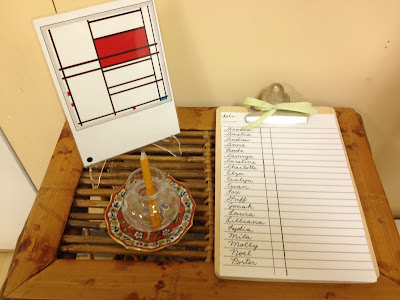Over the years, I have had a version of a Sign-In chart, similar to the one seen in THIS post, for the children to 'check-in' upon arriving to school in the mornings. While I have found this method to work for the most part, I have been wanting to change our sign-in procedure for quite some time. Again, thanks to the extra time a summer schedule affords, I have put together a new sign-in area for my students.
Here, the children are not only provided an opportunity to recognize their name, but also practice writing skills as they place a mark next to their name and/or write their name. Ideally, a larger space could be provided for name writing practice, but I was limited by the size of the clipboard (which was limited by the size of the table, and the table size limited due to the available space...). I selected this Mondrian print to display because we will be exploring primary colors in our art lessons during the first weeks of school. Hopefully, the rotating of various artworks on our Sign-In Table will strengthen our Art curriculum and art appreciation.
Our new Birthday sign hangs directly over the Sign-In Table - I think this will help build and maintain a sense of community within the classroom.
 |
| Our new Sign-In Table upon entering the classroom. |
Our new Birthday sign hangs directly over the Sign-In Table - I think this will help build and maintain a sense of community within the classroom.




